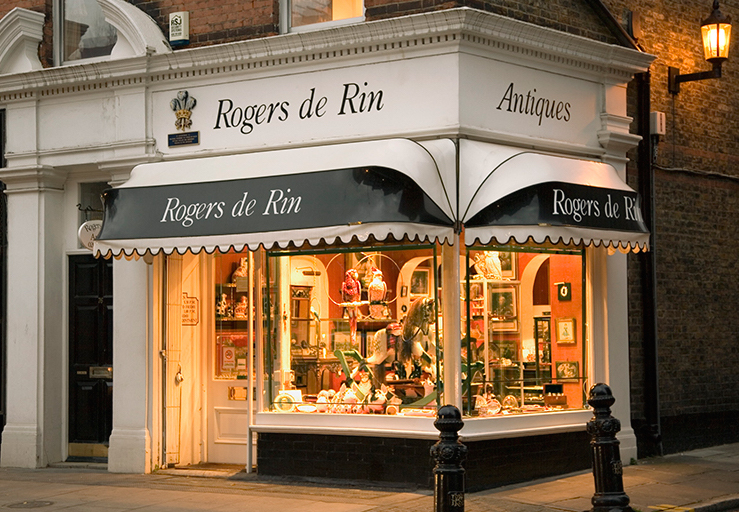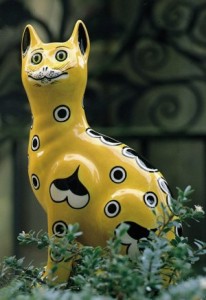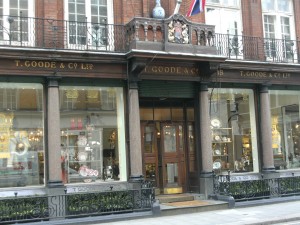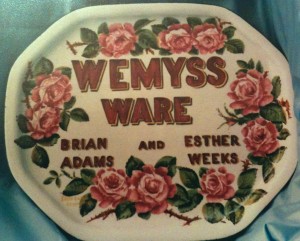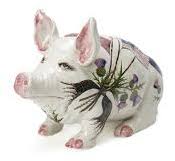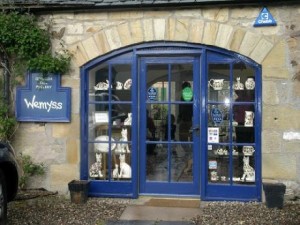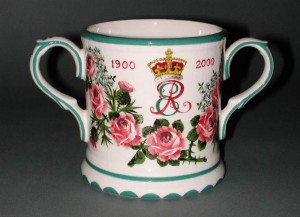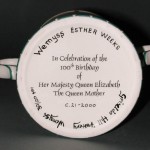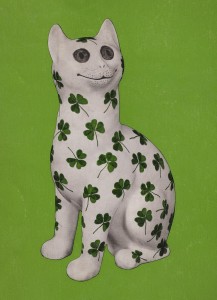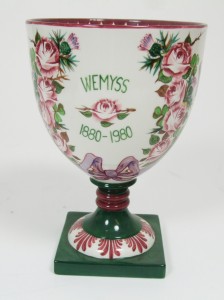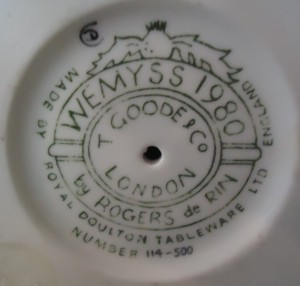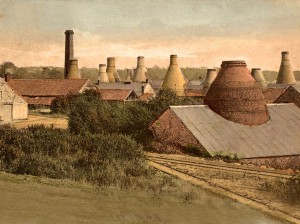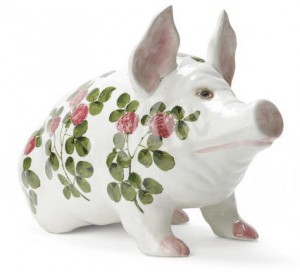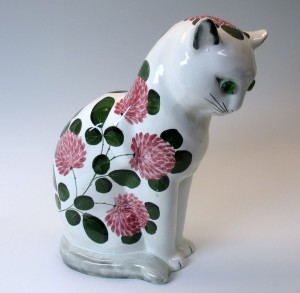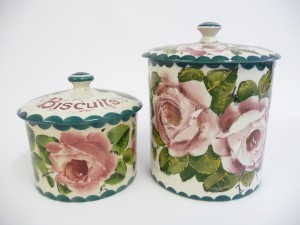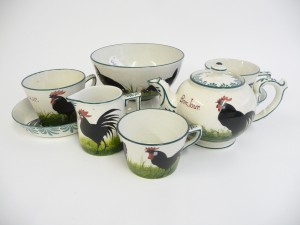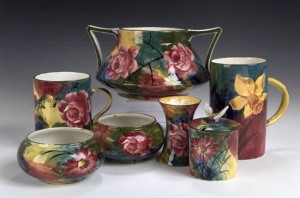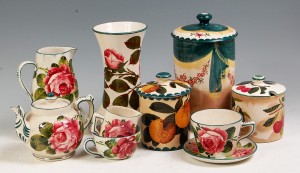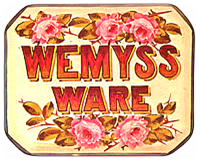Sadly, Brian Adams died on 1st October 2016. This blog post is in tribute to Brian, his considerable talent and of course his contribution to Wemyss Ware.
Background
To those familiar with Wemyss Ware, Brian Adams was well known as the founder of the Exon Art Pottery in Ashcombe, Devon that produced a recreation Wemyss Ware from 1988. However, there is so much more that can be told about Brian’s unique legacy to the Wemyss Ware story. In this post I will attempt to tell some of this story as a short tribute to Brian.
Meeting with Brian
I count myself very fortunate to have met Brian and was able to spend time discussing Wemyss Ware with him. I travelled to Devon in August 2013 to meet with him as part of research for my own Wemyss Ware book. Prior to this meeting I had spoken to him on the phone and discovered that we had two things in common. First of all, we both knew that the Wemyss Ware history, as currently recorded, is peppered with errors and inconsistencies, and secondly we had both been researching the Wemyss Ware history with a view to publishing a book on the subject. However, Brian was already way ahead of me and had published a couple of books that contained some Wemyss history related to the Bovey Tracey pottery and had accumulated a vast file of research and historical documents to support his planned book.
Rather than seeing me as a rival author, Brian was keen to share what he knew with me – his prime motivation being simply to see the Wemyss story accurately recorded. I met him at his home in Ashcombe, Devon – he took me and my wife to the pottery museum at Bovey Tracey of which he was curator. Then his wife Pat made us lunch and we chatted about our common interest as well as our families. I asked Brian about his background and what led to him establishing the Exon pottery. He showed me all sorts of Wemyss related artefacts such as old underglaze colour test pieces and he took us to the Exon Art Pottery studio (at the bottom of his garden) where we talked more about how he tried to perfect his Wemyss Ware. He was a very accomplished artist and I saw many of his fabulous oil paintings hanging on the walls of his house.
I learned so much from him in a single day and he freely let me copy documents from his vast archives. I am hopeful that telling his story will help to mark his rightful place in the history of Wemyss Ware. There will be more on Brian and the Exon Art Pottery in my book but here is a brief history – and if you feel I have got anything wrong please do let me know.
Brian and Exon Wemyss Ware – a brief history
Brian Thomas Adams was born in Reading in 1945. From the age of 16 he worked as a civil servant for local government in weights and measures and then in trading standards. In the early 1970s his interest in painting and pottery grew and by 1982 he had developed sought after skills in restoration and so left local government to become a professional china restorer. Unlike many restorers Brian relied on traditional production techniques and materials for his restorations and so he learned, or re-learned, some of the original techniques. He specialised in recreating extremely authentic copies of old pottery and the Bovey Tracey Pottery Museum, for which he was curator until his death, features many pieces which he had recreated based on evidence of the originals. If it were not for the information labels it would be impossible to distinguish which pieces are 100% original compared with those which have been heavily restored or those which are entirely new recreations made by him.
Brian’s income was as a restorer, but unlike many he focussed on restoration using original production techniques rather than using contemporary methods or shortcuts. This often required experimentation to recreate forgotten methods and get the desired results. This dogged determination paid dividends when it came to his involvement with ‘recreation’ Wemyss Ware.
In early 1987, HRH The Prince of Wales, a Wemyss collector himself, initiated a project to produce a ‘recreation’ Wemyss and had approached Devon antique dealer David Thorn to see if he could assist. David approached Brian as he had been restoring ceramics for him and he agreed to work on the project. By August he had conducted literally hundreds of colour and firing experiments to perfect this new Wemyss and then in September he met with Esther Weeks, the last Wemyss decorator from the Bovey Pottery. The Prince of Wales had arranged an exhibition of new Wemyss at Thomas Goode & Co in London on 25th November 1987 and Brian and Esther in partnership produced 19 pieces for this exhibition.
The Prince of Wales’ project did not progress but Brian continued to work with Esther and after many test pieces they started selling their recreation Exon ‘Wemyss’ in September 1988. Esther’s surviving knowledge of Wemyss decoration combined with Brian’s artistic talent and ceramics expertise enabled them to recreate a new high quality pottery. This led to a very authentic appearance of Exon Wemyss and was arguably the first ware since 1957 that was true to the original technical and artistic ideals of Wemyss Ware. Following some research Brian also concluded that no one actually owned the registered trademark for Wemyss Ware and so he started to mark his Exon ware as ‘Wemyss’.
Exon Wemyss has caused some issues over the years. First of all, it was so close to the original it was claimed it could be passed off as much earlier Wemyss and Sotheby’s actually declared it to be ‘fake’ and placed it in their Black Museum. They also claimed that Doulton owned the Wemyss trademark. Brian was furious and insisted that they issue an apology on two grounds. First it was not ‘fake’ and was marked so that it was easily distinguished from earlier Wemyss, and secondly Doulton only had a claim to the trademark which Brian had disputed (and as it turned out he was entirely correct – they had never owned the trademark). An apology was duly published exonerating both Esther and Brian. Exon Wemyss was further legitimised when Bonhams, the auctioneers, ordered large Exon Wemyss pigs to display in their salerooms and sometimes included Exon Wemyss in their Wemyss sales in Edinburgh.
Between 1988 and 2005 some 2700 Exon Wemyss pieces were produced and most were decorated by Brian. In 1993 Esther decided to work with the Griselda Hill Pottery in Ceres, Fife where they had been producing a recreation Wemyss since 1985. Both Griselda Hill and Brian Adams had attempted to secure the Wemyss Ware trademark for their own potteries but both had been refused initially. Griselda persisted and in 1994 she was finally awarded the trademark. Brian had not noticed the pending application during the consultation period and so had not submitted an objection or counterclaim within the required time. When he found out he was very unhappy but eventually reached an agreement with the Griselda Hill Pottery that he could continue to use the Wemyss mark on his Exon Wemyss. Relatively few pieces were produced after 2005 and Brian latterly concentrated on his painting and writing in addition to being the curator of the Bovey Tracey Pottery Museum located within the old Bovey Pottery.
Brian’s legacy to Wemyss Ware
As mentioned, the legitimacy of Brian’s Exon Wemyss as ‘real’ Wemyss Ware was sometimes questioned and some dealers still do not consider it to be authentic. However, let us consider the facts. It was not that long ago that the Bovey Pottery’s Wemyss Ware was not considered ‘proper’ Wemyss by some dealers, but now it is fully accepted and it has been shown that some cannot even distinguish it correctly from the earlier Fife Pottery Wemyss Ware. Bovey Wemyss had the legacy of some original moulds, they had acquired rights to use the name and through Joe Nekola they also had a skilled decorator from the original pottery. Brian’s Exon Pottery shares a similar legacy – he acquired some of the original moulds, he eventually obtained the right to use the Wemyss mark, and he learned the secret of Wemyss decoration from Esther Weeks who had been trained by Joe Nekola himself. Then consider the painstaking experiments that were conducted to get the firing and the underglaze colours spot on – and the fact that like the original Wemyss decorators Brian himself was a very skilled artist.
Unlike other contemporary Wemyss Ware, I happily display my Exon Wemyss with cabbage rose decoration by Brian Adams alongside other pieces decorated by the recognised Wemyss masters – Karel Nekola, Edwin Sandiland, James Sharp and Joseph Nekola. Brian has left a lasting legacy through several books on pottery and his restoration work that can be seen in the Bovey Tracey Pottery Museum. However, I believe that his greatest legacy will be felt through his Exon Wemyss Ware. It now regularly appears at major Wemyss Ware sales and given its quality and scarcity it will inevitably become sought after and prices will continue to rise.
Gordon Povey

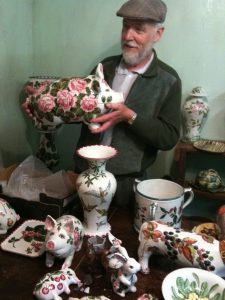
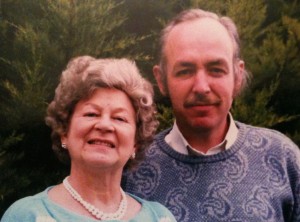
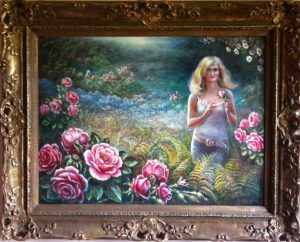
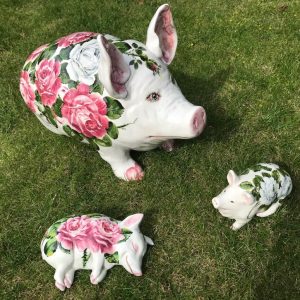
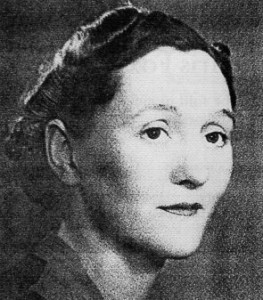
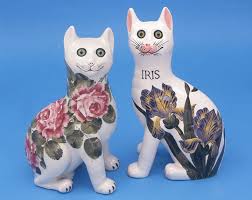 Through her antique shop in West Bow, which leads down to the Grassmarket in Edinburgh, she grew her massive collection of Wemyss Ware as well as German and French porcelain. Her house, Craigievar in the Liberton area of Edinburgh became her “museum” with themed rooms. As an antique dealer it was said that Iris bought a lot more than she ever sold. Her collections ran to many thousands of pieces.
Through her antique shop in West Bow, which leads down to the Grassmarket in Edinburgh, she grew her massive collection of Wemyss Ware as well as German and French porcelain. Her house, Craigievar in the Liberton area of Edinburgh became her “museum” with themed rooms. As an antique dealer it was said that Iris bought a lot more than she ever sold. Her collections ran to many thousands of pieces.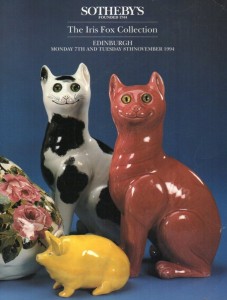
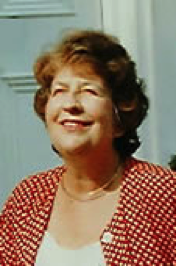
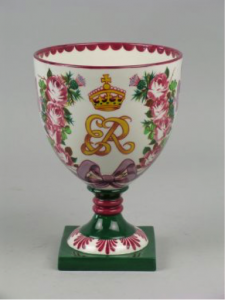 d since 1957, in 1980 to mark the Queen Mother’s 80th birthday a limited edition commemorative Wemyss Ware goblet was produced. This also marked the centenary (approximately) of Wemyss Ware and was produced by Victoria’s company, Rogers de Rin, in conjunction with Royal Doulton who then believed that they owned the Wemyss Ware rights. The goblet was modelled on the one produced by the original Wemyss Ware manufacturer, Robert Heron & Son, in 1887 for Queen Victoria’s diamond jubilee. It was designed by the artist Alan Carr Linford and Esther Weeks (a Wemyss decorator trained by Joe Nekola). Another historical connection with the past was that the official retailer was Thomas Goode & Co of Mayfair, Heron’s exclusive Wemyss Ware dealer for England when the Queen Victoria goblet was produced. A limited edition of 500 goblets were to produced with the first being presented to HM the Queen Mother.
d since 1957, in 1980 to mark the Queen Mother’s 80th birthday a limited edition commemorative Wemyss Ware goblet was produced. This also marked the centenary (approximately) of Wemyss Ware and was produced by Victoria’s company, Rogers de Rin, in conjunction with Royal Doulton who then believed that they owned the Wemyss Ware rights. The goblet was modelled on the one produced by the original Wemyss Ware manufacturer, Robert Heron & Son, in 1887 for Queen Victoria’s diamond jubilee. It was designed by the artist Alan Carr Linford and Esther Weeks (a Wemyss decorator trained by Joe Nekola). Another historical connection with the past was that the official retailer was Thomas Goode & Co of Mayfair, Heron’s exclusive Wemyss Ware dealer for England when the Queen Victoria goblet was produced. A limited edition of 500 goblets were to produced with the first being presented to HM the Queen Mother.